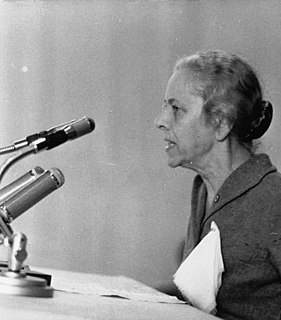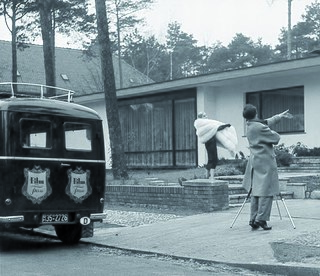Sneschana Russewa-Hoyer | |
|---|---|
 | |
| Born | January 10, 1953 Krushari, Bulgaria |
Sneschana Russewa-Hoyer (born January 10, 1953) is a Bulgarian engraver and medallist. She lives in Berlin, Germany.
Sneschana Russewa-Hoyer | |
|---|---|
 | |
| Born | January 10, 1953 Krushari, Bulgaria |
Sneschana Russewa-Hoyer (born January 10, 1953) is a Bulgarian engraver and medallist. She lives in Berlin, Germany.
She was born Sneschana Russewa in Krushari, Bulgaria. She received her secondary education at an arts school in Sofia. She studied from 1972 to 1977 at the Kunsthochschule Berlin-Weißensee (Weißensee Academy of Art Berlin). [1] In 1976 she married the sculptor Heinz Hoyer , who had finished his studies at the same academy in 1975.
Sneschana Russewa-Hoyer worked together with her husband Heinz Hoyer in the design of many DDR stamps and coins. After the German Unification in 1990 the Hoyers were creating coins and medals for the Federal Republic of Germany with great success. [2]
An example for a coin design is the national side of the German 1 Euro and 2 Euro coins. These coins are the most common coins in use for more than 300 Million inhabitants of the Eurozone. [3]
An example of a medal design is the 2009 farewell medal for Wolfgang Steguweit , the manager of the Münzkabinett der Staatlichen Museen zu Berlin (Bode Museum). [4]
German euro coins have three separate designs for the three series of coins. The 1-cent, 2-cent and 5-cent coins were designed by Rolf Lederbogen, the design for the 10-cent, 20-cent and 50-cent coins were designed by Reinhard Heinsdorff and the 1- and 2-euro coins were done by Heinz Hoyer and Sneschana Russewa-Hoyer. Featured in all designs are the 12 stars of the EU and the year of minting.

The Altes Museum is a listed building on the Museum Island in the historic centre of Berlin. Built from 1825 to 1830 by order of King Frederick William III of Prussia according to plans by Karl Friedrich Schinkel, it is considered as a major work of German Neoclassical architecture. It is surrounded by the Berlin Cathedral to the east, the Berlin Palace to the south and the Zeughaus to the west. Currently, the Altes Museum is home to the Antikensammlung and parts of the Münzkabinett. As part of the Museum Island complex, the Altes Museum was listed as a UNESCO World Heritage Site in 1999, because of its testimony to the development of museums as a social and architectural phenomenon.
Michael Ruetz works as artist and author. He is a German photographer.

The Bode-Museum, formerly called the Kaiser-Friedrich-Museum, is a listed building on the Museum Island in the historic centre of Berlin. It was built from 1898 to 1904 by order of German Emperor William II according to plans by Ernst von Ihne in Baroque Revival style. The building's front square featured a memorial to German Emperor Frederick III, which was destroyed by the East German authorities. Currently, the Bode-Museum is home to the Skulpturensammlung, the Museum für Byzantinische Kunst and the Münzkabinett. As part of the Museum Island complex, the Bode-Museum was inscribed on the UNESCO World Heritage List in 1999 because of its outstanding architecture and testimony to the development of museums as a cultural phenomenon in the late 19th and early 20th centuries.

Johann Gustav Stickel was a German theologian, orientalist and numismatist at Jena University.
Oriental Coin Cabinet Jena is a collection of oriental coins at Jena University, in Jena, Germany, founded in 1840.
Karl Vollers was a German orientalist.
The Karl-Scheel-Preis is an award given annually by the Physikalische Gesellschaft zu Berlin, a regional association of the Deutsche Physikalische Gesellschaft, for outstanding scientific work. The prize was established through an endowment by the German physicist Karl Scheel and his wife Melida. Recipients are awarded with the Karl-Scheel Medal and 5.000 Euros. The Karl-Scheel Medal in bronze was designed by the German sculptor Richard Scheibe and has a diameter of 12 cm.

Hermann Brockhaus was a German Orientalist born in Amsterdam. He was a leading authority on Sanskrit and Persian languages. He was the son of publisher Friedrich Arnold Brockhaus and brother-in-law to composer Richard Wagner. In 1870 he received a combined medal (together with in occasion of the 25th anniversary of the DMG.
Carl Vezerfi-Clemm was a German sculptor, medalist and coin designer. He made commemorative coins issued by the Federal Republic of Germany, medals, sculptures and other creations.

Ludwig Gies was a German sculptor, medallist and professor of art. He is best known for his crucifix in Lübeck Cathedral, vandalized in March 1922 and later considered a typical work of degenerate art, and his famous Federal Eagle (1953), which is hung at the front of the Plenary Hall of the Reichstag in Berlin.

Nanne Meyer, is a German artist. She is one of the first women artists of the postwar generation who works primarily in drawing. Meyer lives and works in Berlin.

Paul Sturm was a German art nouveau sculptor, medallist and designer.

Rudolf Hellgrewe was a landscape painter and illustrator. He taught for a long time at the Kunstgewerbemuseum in Berlin. He is the most famous painter of Germany's colonies.

The Museum of Islamic Art is located in the Pergamon Museum and is part of the Staatliche Museen zu Berlin.

Mathilde Danegger was an Austrian stage and movie actress. Sources may also identify her by the pseudonym, Mathilde Leusch; Leusch is apparently a variant of her second husband's surname (Lesch).

Franz Christian Gundlach was a German photographer, gallery owner, collector, curator and founder.

Otto Kümmel was a German art historian, academic teacher, founder and director of the Museum of Asian Art in Berlin and general director of the Berlin State Museums.

Dieter Bernhard Herrmann was a German historian of astronomy and author of numerous popular science books on astronomy. He was director of the Zeiss Major Planetarium in Berlin from 1987 to 2004. In his scientific work he dealt with the early development of astrophysics and the application of quantitative methods in the history of science.
Barbara Göpel, née Barbara Malwine Auguste Sperling was a German art historian.